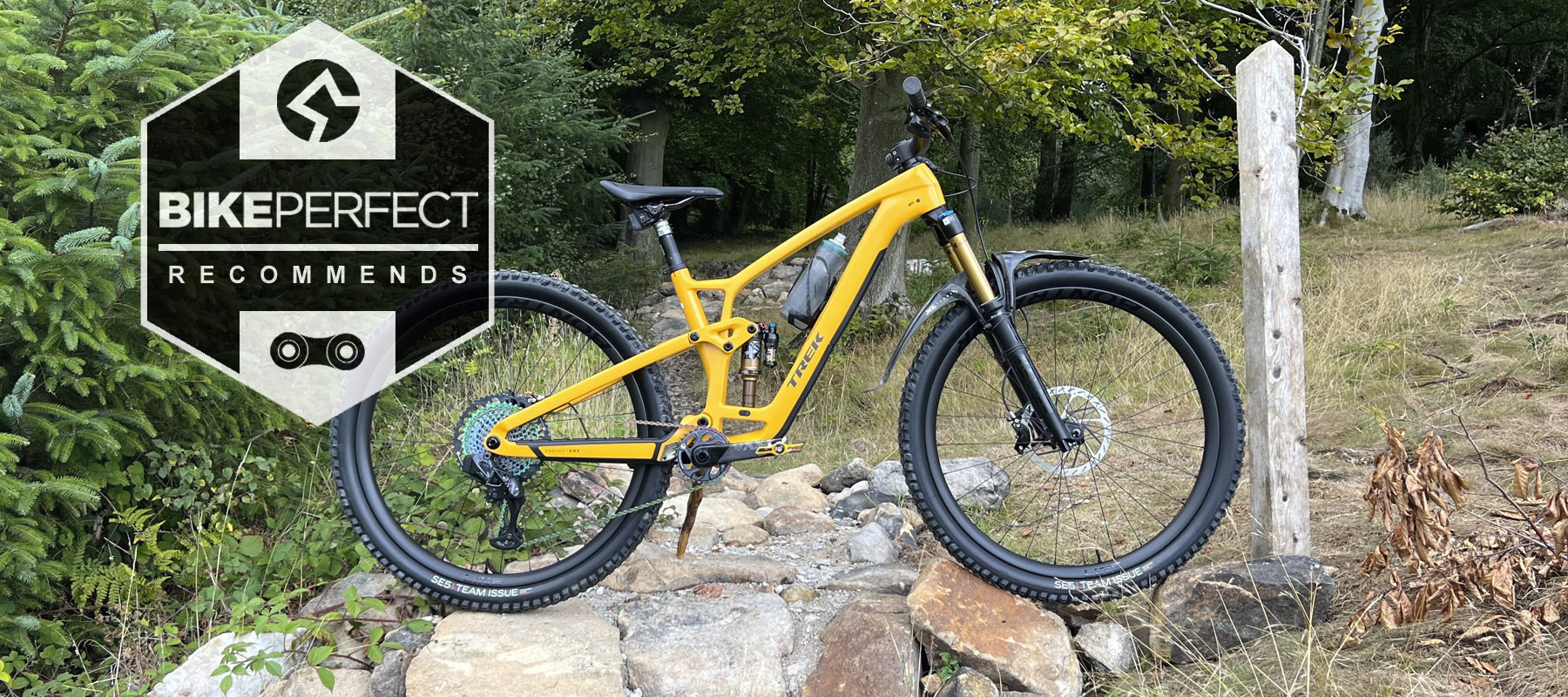Bike Perfect Verdict
An excellently balanced all-rounder with more control, adjustability, practical features and shock compatibility than before and a lifetime warranty. This all comes with a hefty price tag though, and while the Fuel EX pops and plays surprisingly well, it’s heavy for it's spec and category.
Pros
- +
Superbly balanced adjustable geometry
- +
Awesome suspension performance in ‘progressive’ mode
- +
Poppy, playful and fast-climbing for its weight
- +
Truly premium wireless, Fox Factory, carbon-loaded spec
- +
Lifetime warranty, threaded BB and tunneled routing
Cons
- -
Heavy for spec and travel
- -
Costs more than parts sold separately
- -
Default shock set-up is too linear
- -
Headset adjustment is laborious
- -
XX1 is fragile for aggro trail use
Why trust BikePerfect
Trek’s Fuel EX has been their best trail bike option for a decade, with an update every two years making this latest version the sixth generation. It’s a totally new bike too, with radically different geometry, more travel and a complete reversal of Trek’s previous proprietary shock obsession.
The result is obviously right up there with the best premium mountain bikes even on a first ride but it’s worth tweaking shock position and conventional sag settings straight away. The pricing on this fully wireless flagship doesn’t add up either.
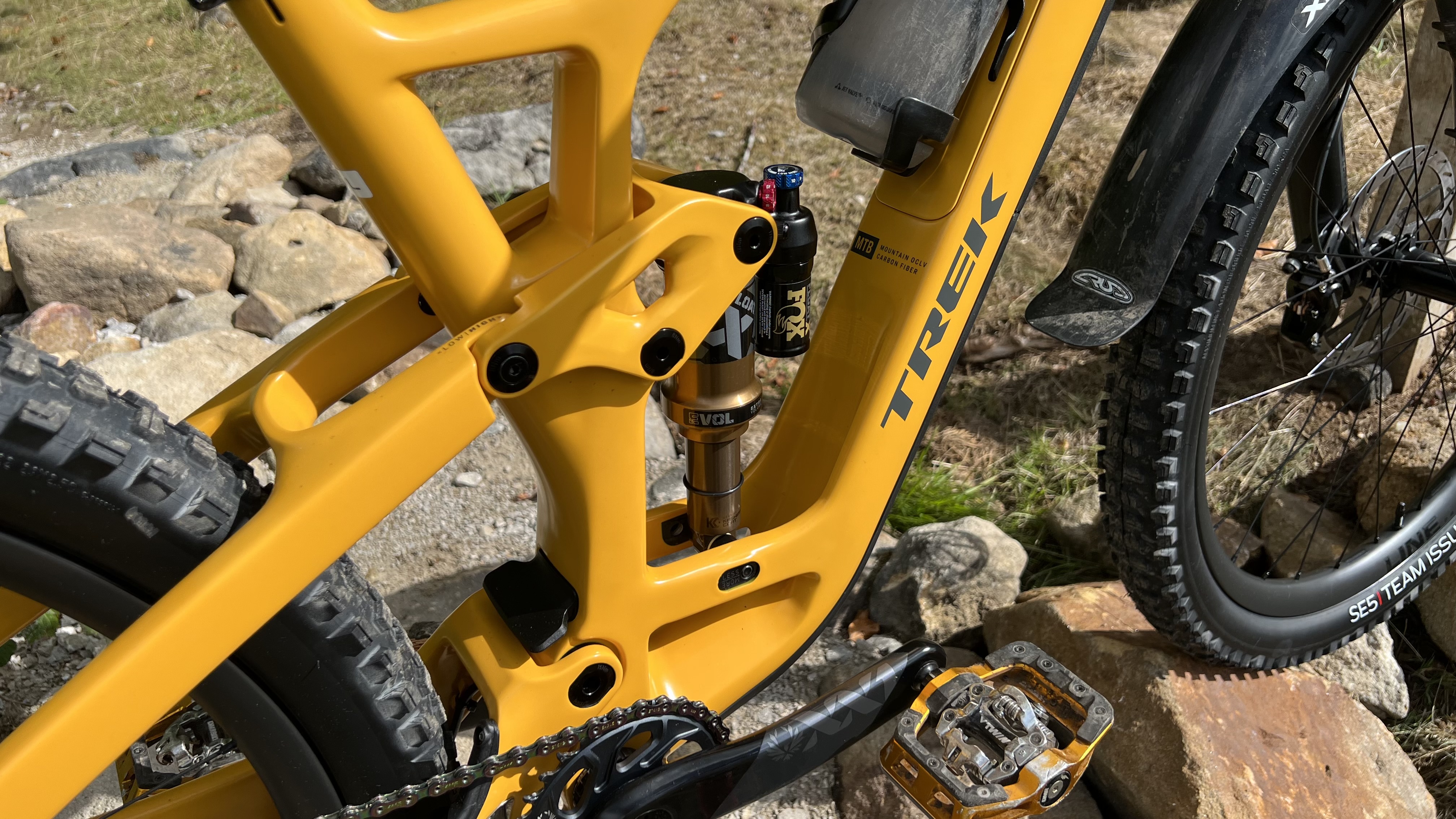
Design and geometry
While some bikes aren’t currently changing much between versions, Trek had some significant work to do to reposition the Fuel EX between the new more trail/play, less race Top Fuel and the full ‘assert Enduro dominance’ Slash. So while the overall seat tube-mounted rocker link and rear axle concentric ABP (Active Braking Pivot) rear pivot layout hallmarks are unchanged, geometry and details see big alterations.
Head angle comes set at 64.5º with the ‘MINO’ rocker/seat stay pivot chip in slack/low (65º in steep/high). You can also buy 1º +/- Aheadset cups to give 63.5º (slackest) or 66º (steepest) settings. That’s a proper 'knock out lower cup, press a new one back in’ process for the workshop – not something you can do trailside like on Specialized’s Stumpjumper Evo or Scott’s Spark. Seat angle is an average of 2º steeper with a 77.5º effective angle on my M/L test sample but a range of 78.6º to 76º across the XS to XXL size range. Reach increases by an average of 20mm, bringing the M/L up to 470mm while different mount points mean the same chainstay pieces give a range of 435mm to 450mm across the size span.
Seat tubes are shorter for more standover/long dropper post space and like the latest Top Fuel the diameter is upsized to 34.9mm for a stiffer, stronger post. Bottom bracket height is either 338mm or 346mm in the 64.5/65º head angle settings. Handling geometry isn’t the only change you can make either as the trunnion upper mount shock bolts into an eccentric mount ‘less/more’ chip in the bridge pieces above the downtube. Flipping this round creates a more progressive shock feel and increased end stroke bottom out. That’s meant to cater for more aggressive riders or those wanting to use a coil shock, but as you’ll see later I reckon that’s the best setting even for mellower trails and with the Float X air shock fitted.
Trek have also scooped out the downtube so that you can fit pretty much any piggyback air or coil shock including Fox, RockShox, DVO, Cane Creek, EXT and even Push although that big external damper won’t fit on the smallest frames. That does squeeze internal storage space slightly so squeezing a standard inner tube downwards is a bit of a wrestle. There’s plenty of room up towards the head tube for Trek’s neoprene organiser wrap. Opening the latched lid (colour coded replacements available if you lose it) also lets you see the new braided carbon guide tubes for rear brake and rear gear cable (if fitted). Thankfully Trek have kept away from the maintenance nightmares of piping cables and hoses through the stem and headset . The cage on the storage hatch takes a 440-770ml bottle depending on frame size.
Wheel size is also related to frame size with the XS rolling on 27.5in, small frames in 27.5 or 29in format and 29in for medium upwards. S sizes upwards can be run mullet if you flip the MINO link to high, although Trek recommend you fit a 160mm fork spring if you do go party out back. Other changes include a move to a threaded bottom bracket with ISCG guide tabs rather than a press fit design. You get a two piece bolt on dual density rubber downtube armor to protect against flying rocks and tailgates, plus chain and chain stay protectors too.
That all brings frame weight in at a relatively hefty 3.4kg weight and similarly hefty £4,000 cost with shock and fixtures. That does get you a lifetime warranty for the original owner and a three-year from new warranty option if you sell it on and the frame is cleared for use with 160mm forks. The carbon bikes come in seven sizes (there are 27.5 or 29in wheel options in the small) as well as the sweet spot M/L inbetweener size I tested. The XXL option only comes in the alloy frame, though.
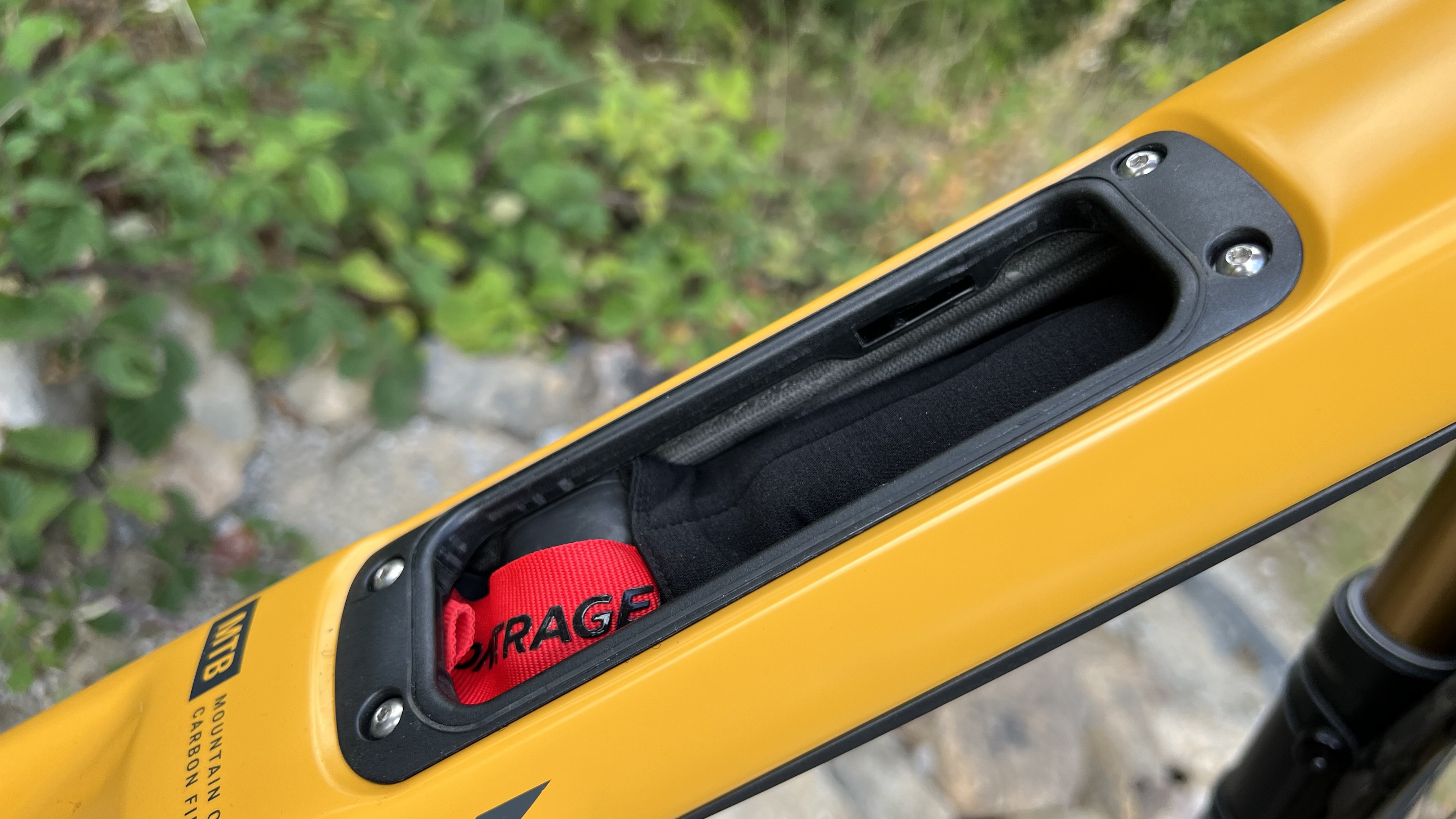
Components and build
The new (the EX5 uses the old frame) Fuel EX range starts with the alloy framed EX7 at £3300. The OCLV Mountain Carbon frames come in with the Shimano SLX/XT Fuel EX 9.7 at £4800 and then two Shimano (XT and XTR) and two SRAM wireless (GX and XX1) models top out with the £11,750 flagship tested here.
That gets you a full XX1 AXS wireless controlled group with superlight hollow carbon cranks and carbon cage rear mech, as well as the awesome Reverb AXS wireless dropper post. Brakes are SRAM Code RSC with 200/180mm rotors, too. The suspension is Fox Factory, with a 36 Float Grip2 fork and Float X air shock.
Trek house brand Bontrager fill the rest of the gaps with their super fancy £350 Race Shop Limited one-piece carbon cockpit with an effective stem length of 45mm and a massive 820mm width. They also supply the 27mm deep, 29mm wide, 1780g weight carbon fibre rim Line Pro 30 wheels with Rapid Drive 108 freehub giving a super quick 3.3º engagement. The tires are Bontrager SE5 too, with a Maxxis DHR style tread in a single 50 Duro ‘TM-Grip’ soft compound on 120tpi ‘Core Strength’ casings. Grips are Bontrager and the ‘Austenite’ railed saddle and mini tool that you can pull out of the fork steerer carrying Keith’s name.
That’s certainly an impressively top spec parade of kit, but complete bike weight is still higher than most of its competitors. Also, if you bought the frame and parts separately, even at full retail you’d be saving around £1200 compared to the complete bike cost.
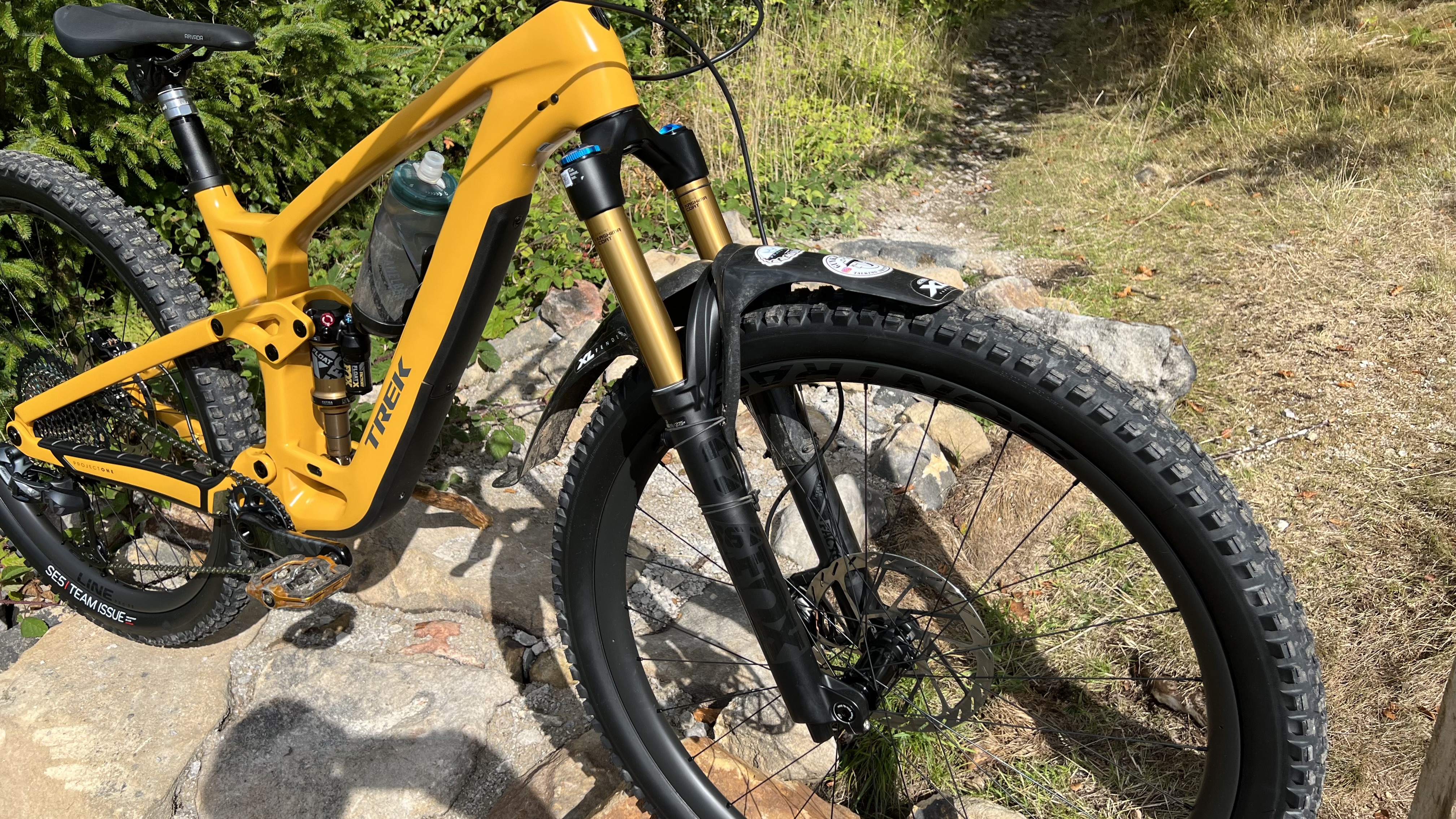
Ride, handling and performance
The good news is that whatever spec you can afford/justify the fundamentals and features of the new Fuel Ex are all the same and they’re extremely well sorted. I’ve only managed a day of testing on the bike so far, and the adjustable headset cups aren’t available yet, but I rode it far and hard enough to get deep into its many pros and the few cons.
First up the stock geometry is beautifully centred and balanced. It’s not a long bike, especially as the steep seat angle naturally pushes you forward but I never felt cramped or compromised. The massive bars and 64.5º head angle, with sticky tyres and my favourite Fox fork give the front end a huge amount of confidence even in first wet trails of the season conditions. If anything the deep rims, stout front end and stiff bar and stem combo are slightly too rich in feedback if you prefer a more forgiving softer ride. It’s definitely not as punishing and surgically efficient as the ultra precise Trek Slash 9.9, though.
Despite being the same weight as its 170/160mm travel sibling in analogue SRAM X01 spec the Fuel EX keeps a distinctively playful feel as soon as you want to pop, hop or hip around the trails. The fast-reacting rear hub and efficient, minimal bob suspension action means it picks up speed far more easily than we expected for its relatively high weight . That gives it an infectiously effervescent feel that encourages you to hustle it along rise-and-fall trails much harder and faster than the significantly lighter but softer pedal- feel Canyon Spectral and Specialized Stumpjumper EVO. It sits just below the latest Santa Cruz Hightower in terms of stomp and go stability, but that means less kickback and traction disturbance when things get rough and random.
The easy stroke of the Float X shock means it blows through its travel with very little provocation in the default ‘less’ progression chip position and 30% sag. It still blew through more easily than I expected/wanted at 25% sag too, but switching the chip to the ‘more’ position improved things noticeably. Heavier riders/landers are going to want significantly more progression than that, however, so prepare to add volume spacers in the shock if that sounds like you.
If you’re tempted to go the coil route we’d definitely suggest something with plenty of natural mid-stroke support or even a progressive wound spring rather than a wallower like Fox’s DHX shock. While the 4mm wide sidewall tops add protection to the wheels and tires we’d be tempted to put an insert in the rear tire too. That’s because we regularly rimmed out the back wheel with a serious bang which is possibly due to the arcing, rather than rearward wheel path of the ABP pivot kinematic.
Once we’d found the shock sweet spot, though, the balance of neutral pedaling stability, cornering support, supple traction through turns or rock crawling up janky technical challenges was fantastic. In fact, the mix of ultra sensitive suspension ‘flutter’ and utterly planted authority gave me really sorted e-bike vibes on a regular basis. Because the suspension doesn’t have a specific agenda you can really concentrate on making the most of the excellent handling balance (that steep seat angle is a gift for climbing) and it loves to multiply whatever power and skill you can bring to the party. That meant even on a dead leg day it made short work of my most challenging local test trails in a consistently calm yet dynamically exciting, encouraging way, rather than just dull diligence.
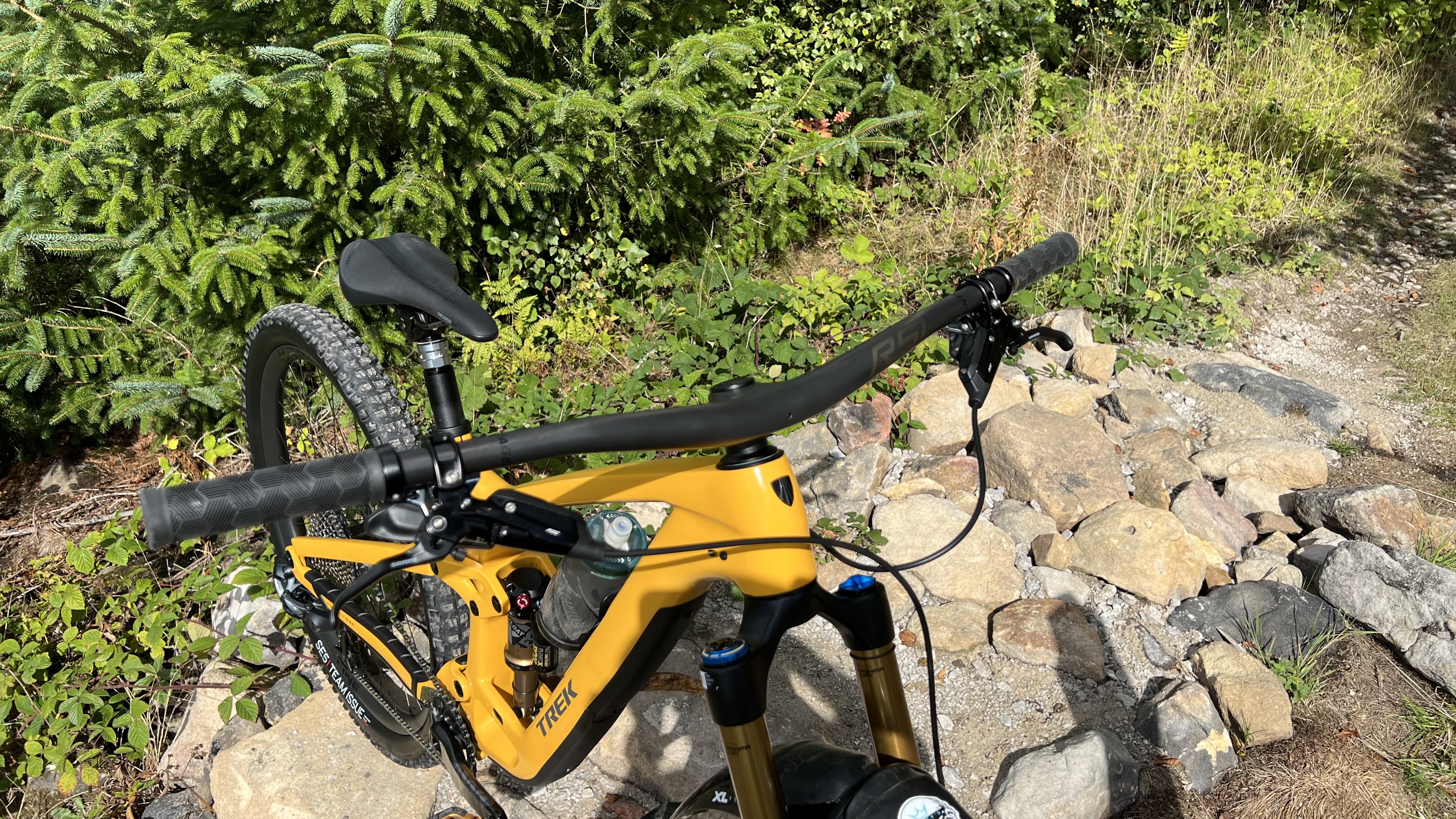
Verdict
It’s really early days in my relationship with the Trek Fuel EX, but aside from the complete bike pricing and the initially over-enthusiastic shock stroke , it’s clearly a brilliantly balanced all-rounder. It slides really well into the ready for anything slot between the Top Fuel and Slash in Trek’s range and feels like a sweet spot between the softest and sharpest feeling category benchmarks too.
While it’s heavy for the kit/competition and we’d question the wisdom of full carbon XC components on such a rugged ride, it also pops, climbs and plays as though it’s a lot lighter than it actually is. The lifetime warranty, plus increased adjustability and versatility potentially, will add significant dividends deeper into its lifespan and the for the development of your riding, too. I’ll be heading out on it again as soon as I post this review , which is always a very good sign of how much I’ve enjoyed riding it so far.
Tech specs: Trek Fuel EX 9.9 XX1 AXS
- Discipline: Trail/Enduro
- Price: £11,750
- Head angle: 63.5 - 66º
- Frame material: OCLV Mountain Carbon
- Fork material: Carbon fibre monocoque
- Size: XS, S, M, M/L (tested), L, XL, (XXL in alloy frames only)
- Weight: 14.59kg
- Wheel size: 29 x 2.5in
- Suspension: Fox Factory 36, Float GRIP2 fork 150mm travel, Fox Factory Float X 185mm x 55mm shock
- Components: SRAM XX1 Eagle AXS 12 speed rear mech, shifter and 30T SRAM XX1 chainset with DUB bottom bracket. SRAM Eagle XG-1299, 10-52, 12 speed cassette. SRAM Code RSC hydraulic disc brakes with 200mm front and 180mm rear rotors. Bontrager SE5 Team Issue 29 x 2.5in tires on Bontrager Line Pro 30, OCLV Mountain Carbon wheels. Bontrager RSL Integrated handlebar/stem 820mm bar and 45mm stem, RockShox Reverb AXS, wireless, 34.9mm seat post and Bontrager Arvada, Austenite rails saddle.

Guy Kesteven has been working on Bike Perfect since its launch in 2019. He started writing and testing for bike mags in 1996. Since then he’s written several million words about several thousand test bikes and a ridiculous amount of riding gear. He’s also penned a handful of bike-related books and he reviews MTBs over on YouTube.
Current rides: Cervelo ZFS-5, Specialized Chisel, custom Nicolai enduro tandem, Landescape/Swallow custom gravel tandem
Height: 180cm
Weight: 69kg
